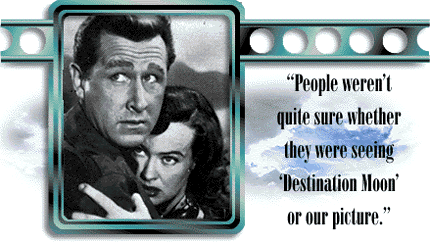| |
- By TOM WEAVER
-
Years before the expression "race to space"
denoted the competition between the United States and
the Soviet Union, two Hollywood moviemakers were locked
in a competition of their own. Producer George Pal was
taking pains with his production of Destination Moon,
spending well over half a million dollars on the film,
working with scientists and space travel experts to
create an avalanche of advance publicity. B movie maven
Robert L. Lippert decided that his company could quickly
knock out a half-alike film, beat Pal to the finish
line and take advantage of his rival's initiative and
costly promotion. Lippert's film was Rocketship X-M.
"I don't know how much artistic value Lippert
gave to a piece," the film's star Lloyd Bridges
recalls, "but he was crazy about motion pictures,
and had seen just about every one that was ever made.
Most of the things he did were the so-called B pictures
of the day, but he made his impression on the business
I think. With Rocketship X-M, we did beat our
competitor, Destination Moon. And they paid a
lot more for their production. We kind of took advantage
of the publicity they were putting out -- people weren't
quite sure whether they were seeing that picture or
our picture."
Lifting off from the Government Proving Grounds in
White Sands, New Mexico, the multistage RXM is the first
manned rocket into space, with a lunar landing and exploration
planned. But a storm of meteors sends the rocket off
in a new direction at incredible velocity, toward Mars.Taking
advantage of the opportunity, the crew of five -- Bridges,
John Emery, Osa Massen, Hugh O'Brian and Noah Beery
Jr. -- land and scout the planet's barren surface, finding
evidence of a long-ago civilization destroyed by an
atomic war. Savage Martian cave dwellers attack, killing
Emery and Beery and wounding O'Brian. The survivors
escape aboard the RXM, but a fuel shortage spells disaster.
After shortwaving a full report to the base, Bridges
and Massen declare their newfound love for one another
as the rocket plunges to a devastating crash landing
on Earth.
"I begged the director not to shoot that love
scene, when we're plummeting to Earth and we pour out
hearts to one another," Bridges asserts. "I
told him, 'You know, at a time like that, it just doesn't
make sense.' It seemed so wrong to me to destroy the
illusion; I was sure people would laugh at it. But he
insisted, and who knows whether he was right or not."
The director, Kurt Neumann, is best recalled today
for his science fiction films such as Rocketship
X-M, Kronos and The Fly, but Bridges remembers
him mostly as "a man who believed we had to do
it fast. We had a very short schedule. I think maybe
ten days or something like that. When we went out on
location to film the scenes of Mars, we went out to
Death Valley, and we had to put on our own wardrobe
and makeup en route, in the plane, so that as soon as
the plane landed, we were ready to work right away.

-
- "Everything went smoothly and fast [in the
Death Valley scenes]. It had to -- or else they'd
just skip the scene. I always felt that we should
never have seen any of the Martians, they should have
been just shadows. Imagination is stronger than actually
seeing. (Not many of my suggestions were taken, as
you may have noticed!) But I did think that the red
tinting of the Martian scenes was a good idea, and
Death Valley turned out to be a good location for
us. It looked a bit like what we later found out the
Moon was like.
The Rocketship X-M interiors, Bridges continues,
were shot "in the studio. I don't know how much
of that [aeronautical equipment] was real; it was before
its time, so I guess they figured they could be pretty
freethinking about it. They were a bit crude, all of
the Rocketship X-M effects, when you look at 'em today."
Bridges also remembers the cast as a "very congenial"
group of actors. "Osa Massen we don't see much
of lately, but for quite a while we kept in touch. She
was a very sweet person; she had been an editor for
some time before she became an actress, She had a fascinating
kind of personality, I thought, and she was a beautiful
girl. In fact, Hugh O'Brian was very much in love with
her -- I guess we all were. John Emery was quite the
Shakespearean actor, always spouting Shakespeare, and
as a matter of fact, a lot of people thought he was
very much like John Barrymore. I remember that he kind
of patterned himself after Barrymore to a certain extent;
he always had some sort of Barrymore-like comment to
make about everything. I think he was trying to figure
out how he found himself in the desert, among the rocks,
making Rocketship X-M, when he should have been in the
theater doing Shakespeare!"
Bridges asserts that the people behind Rocketship
X-M had no idea it would become any sort of classic.
"I'm not sure that it has -- has it? Well, because
it was one of the first films of its sort, I guess it
might be true. I don't remember that it did my career
much good. It was considered a B picture, and you never
make much of an impression on the industry if you're
in a B picture. Not even if you're in a good one."
Does he consider Rocketship X-M "a good
one?" I like it, except that last love scene continues
to bother me. I just can't imagine that any two people
would be that calm about it all."
Tom Weaver is the author of Science Fiction and
Fantasy Film Flashbacks, Attack of the Monster Movie
Makers and many others available from McFarland
& Co.
|